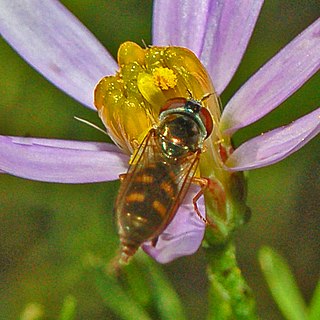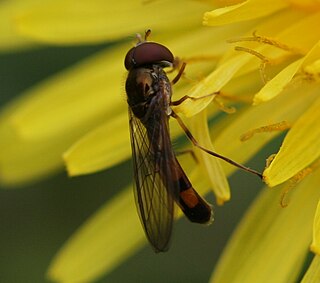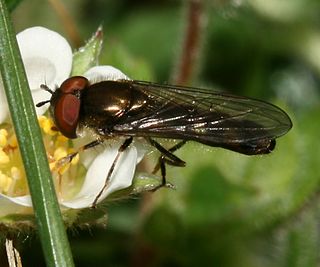
Eristalinae are one of the four subfamilies of the fly family Syrphidae, or hoverflies. A well-known species included in this subfamily is the dronefly, Eristalis tenax.

Platycheirus clypeatus is a species of hoverfly. It is found across the Palearctic and in the Nearctic. The larvae feed on aphids. Adults are usually found on the edges of woodland or scrub, heath or along hedgerows where they visit a wide range of flowers.

Eupeodes luniger is a common species of hoverfly.

Platycheirus scambus is a species of hoverfly. It is a Holarctic species.

Platycheirus peltatus is a Palearctic species of hoverfly.

Platycheirus scutatus is a very common species of hoverfly. It is a Holarctic species.

Melanostoma scalare, the chequered hoverfly, is a very common species of hoverfly.

Baccha elongata is a species of hoverfly in the genus Baccha.

Platycheirus albimanus is a common widespread species of hoverfly. A holarctic species its range includes Greenland, Iceland, Britain, mainland Europe, Russia, across Siberia to the pacific coast, the Philippines, Alaska, western Canada and United States.

Platycheirus manicatus is a species of hoverfly. It is found across the Palearctic and in Alaska.

Pipizini is a tribe of small to medium-sized generally black hoverflies, although some species also have orange spots on their abdomen. This nondescript colouring can lead to some species being confused with other dark hoverflies from other tribes. The lack of a facial knob is a good defining feature which separates them from most of these other hoverflies. As with other species in the subfamily Syrphinae the larvae feed on aphids though there seems to be a preference for wax-secreting aphids e.g. Pemphigidae.

Anasimyia contracta is a European species of hoverfly.

Anasimyia lineata is a Palaearctic species of hoverfly.

Parhelophilus consimilis is a Palearctic hoverfly.

Trichopsomyia flavitarsis is a European species of hoverfly.

Platycheirus ambiguus is a small widespread species of hoverfly found across the Palearctic from Ireland to Japan. A spring species found in flight in April and May, it visits spring-flowering trees and shrubs, e.g., Prunus spinosa in deciduous woodland and scrub.

Platycheirus angustatus is a species of hoverfly. It is found in many parts of the Palearctic, and in the Nearctic.
Platycheirus nielseni is a Holarctic species of hoverfly.
Paragus constrictus is a species of hoverfly. It is found in Southern Sweden and Denmark, Ireland, Spain, Germany, the French Alps, Switzerland, Austria, Italy, Yugoslavia and Turkey and Russia east of the Urals. This species may be distinguished from Paragus tibialis only by the shape of the male parameres. In both sexes it shares with P. tibialis the character of entirely pale-haired abdominal tergites, so it is distinct from Paragus haemorrhous which has dark hairs. Images representing Paragus constrictus

Eumerus funeralis or lesser bulb fly is a species of Hoverfly, from the family Syrphidae, in the order Diptera. E. funeralis appears in Peck (1988) as a synonym of E. strigatus (Fallen), but was reinstated as the correct name for tuberculatus Rondani, sensu auctorum by Speight et al. (1998).


















